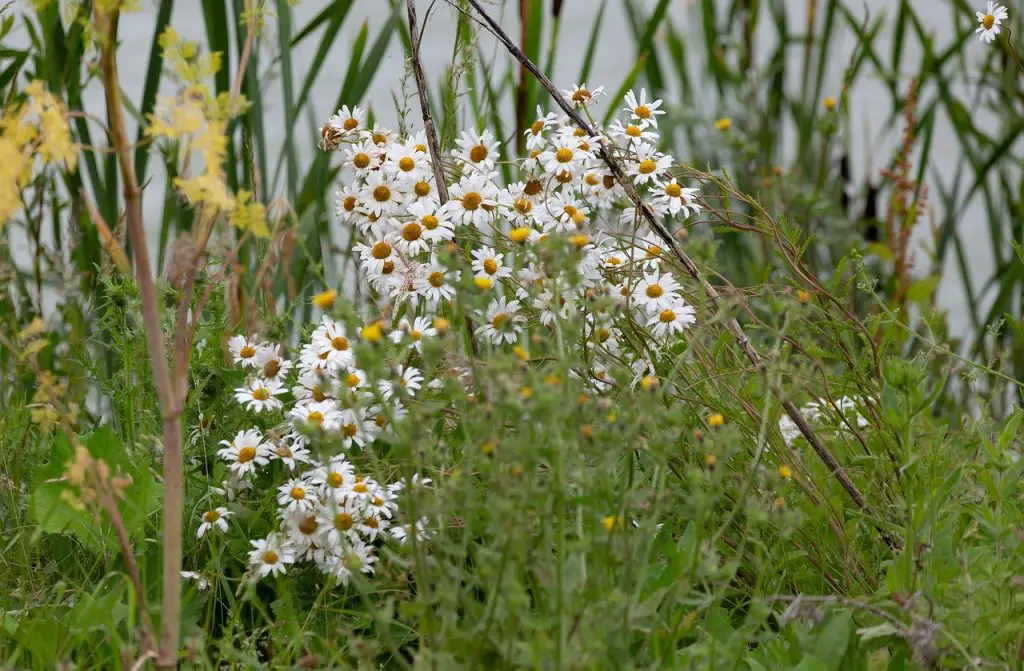A perennial wildflower resembling the shasta daisy, the oxeye daisy is considered especially cheerful and magical in the eyes of many plant enthusiasts. Easy to identify and growing anywhere where there’s rich soil, oxeye daisies are edible and a palatable salad vegetable.
There was a belief in France that the oxeye daisy was connected to divination. In the context of divine timing and wisdom, petals are still picked to determine the luck of love in the modern game of “he loves me, he loves me not”.
Read on to find out more about this special plant.
Leucanthemum vulgare plant profile
| Scientific name | Leucanthemum vulgare |
| Family | Asteraceae (Aster family) |
| Plant type | Herbaceous perennial wildflower |
| Kingdom | Plantae |
| Genus | Leucanthemum |
| Order | Asterales |
| Phylum | Magnoliophyta |
Common names include:
What Are You Foraging For Right Now?
We're thrilled to hear your ideas. What would you like to submit today? Feel free to share your thoughts and experiences with us.
- oxeye daisy
- dog daisy
- field daisy
- Marguerite
- moon daisy
- moon-penny
- poor-land penny
- poverty daisy
- white daisy
Due to the fact that the blooms come in a vivid white color exhibiting a bold goldish-yellow center, its Latin name Leucanthemum likely originates from the ancient Greek word “leucos,” which means white.
The name ‘daisy’ comes from the Greek word for ‘day’s eye’, due to the fact that the flower closes at night.
How to identify oxeye daisies
These flowering plants are erect in form and grow between 1 and 3 feet tall and 1 and 2 feet wide. The broadleaf evergreen foliage of this herbaceous perennial has a fine texture.
The leaves are toothed and deeply cut, and measure 1 to 5 inches in diameter. Longer leaves are found at the base of the plant.
Flowering occurs between May and August, with a flattened yellow disk resembling an ox’s eye. Each flower measures between 1 and 3 inches in diameter and consists of seven to twenty white petals.
The stems are thin and can reach a height of 1 to 2 feet, usually branching out to produce two or more flower heads at a time.
Oxeye daisies grow as a basal rosette of glossy, deep green foliage with scalloped margins. The plant produces one or more flowering stems in the early summer.
It has larger and juicier basal leaves than the stem leaves, and in milder regions, the basal rosette overwinters.

Where do oxeye daisies grow?
Oxeye daisies are widely distributed throughout Britain and Europe, and they have also spread to North America and across all continents as far as New Zealand.
They can be found almost anywhere where there’s rich soil. Although they prefer grassy habitats, especially meadows and pastures, they can tolerate coastal cliffs, dunes, waste ground, and railways.
Often, they are sown on roadside verges, producing continuous ribbons of color.
Are oxeye daisies Invasive?
Oxeye daisies are classified as noxious weeds in certain areas. Despite its ability to become abundant in disturbed areas, it is not a significant threat to native habitats of high quality. As a result of colonizing fields and out-competing other vegetation, this plant is placed on the quarantine list of Washington State.
The plant spreads not only by self-seeding but also by rhizomes, eventually taking over unwanted areas such as crops, pastures, and lawns.
An average plant produces 1,300 to 4,000 seeds per year, and a particularly vigorous plant can produce as many as 26,000 seeds that germinate rapidly when they fall on bare ground.
Seeds of the oxeye daisy are tufted and dispersed by the wind and in dung. Seeds of these plants can be moved along with timber, contaminated forage grass, and legume seeds, too, and will typically remain viable in the soil for at least 20 years (sometimes up to 39 years).
It is important to remove oxeye daisies before they produce seeds in order to prevent them from becoming invasive.
For weed control, be sure to pull plants by the roots. Because oxeye daisies have a shallow root system, they are easy to pull out completely. In fact, cutting, mowing, trampling, and grazing promote the establishment of this plant.
Can you eat oxeye daisies?
Oxeye daisies are edible and considered a palatable salad vegetable. You can eat the petals, stems, and leaves raw in salads or sandwiches or add them to soups and stews.
Young specimens of the plant can be bitter, so it is recommended to add them sparingly to salads or other dishes such as omelets.
For an aromatic taste, young shoots and buds can be lightly steamed. You can also use the flower heads to decorate salads and other dishes.
Even though the oxeye daisy is not poisonous, it can give milk an off-flavor if it is consumed by animals. The oxeye daisy is eaten by horses, sheep, and goats, but it is avoided by cows and pigs.
Oxeye daisies can be eaten as a hiker’s snack, but eating too many of the yellow centers of the flower may result in indigestion.
Can you grow oxeye daisies?
Planting this wildflower is easy:
- Seeds should be sown in early spring or late winter
- Place them 12 inches to 3 feet apart in perennial beds and borders, in a cottage garden, in a wildflower patch, or in a moon garden where their white blossoms will glow at night.
- Oxeye daisies can also be planted in meadows, naturalized areas, near septic systems, or around patios, if they have enough space to grow
Growing tips
Place the plant in a sunny location, preferably in full sun. It is also capable of growing in partial shade or afternoon shade, especially in hot and humid climates.
Sow seeds in average, well-draining soil. Sandier soils can also support plants.
The oxeye daisy is drought-tolerant, so let the soil dry out between waterings. During the sprouting process, seeds should remain moist at all times. After that, watering should be reduced to one to two inches per week.
Oxeye daisies can survive temperatures as low as 28 degrees Fahrenheit. For it to grow, reproduce, and flourish, it requires 130 frost-free days.
Deadhead the flowers regularly in order to promote more blooms.
Ana has always been interested in all things nature and flora. With her expertise in home gardening and interest in foraging, she has been spending her weekends and free time looking for edible native plants, flowers, and fungi. One of her many hobbies includes testing new savory and sweet recipes, juices or teas made from freshly picked plants, wild fruits, or mushrooms.

